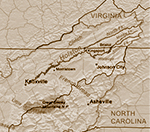 |
||||
|
||||
Renfro Family |
||||
| also spelled Renfrow, Rentfroe, Rentfro, Rentphrow, Ranfrow | ||||
Joseph Renfro was born about 1700. He married Mary Randolph. Joseph and Mary's children may have included: Joseph Renfro (1733) Joseph Renfro was a lieutenant in the French and Indian Wars. Five sons of Joseph Renfro were officers in the Revolutionary War. In June 1780, Joseph died in a raid. |
||||
|
|
|
||
|
|
|||
Stephen Renfro, Sr. was born about 1707 in Virginia. His father was William Renfro. He married Esther Van Bibber. Esther Renfro (1739, married John Looney, son of Robert and Elizabeth Looney), After Esther died, Stephen married Margaret Rhea Looney. She was the daughter of Matthew Rhea and the widow of Robert Looney. Stephen, John and Stephen, Jr. signed the 1777 petition of Holston men. In 1782, Steven Sr. and Jr. received land warrants in Sullivan County. |
|
|||
|
||||
Joseph Renfro was born about 1767 in Virginia. Joseph's children probably included: Absalom C. Renfro (1794, married Levicy Tipton), About 1824, several members were excommunicated from the Sinking Creek Baptist Church. The church split over who was to baptize Fanny Renfro. The excommunicated included Joseph Renfro. They went to Boones Creek Baptist Church. At the time of the 1830 census, the family was in Carter County, Tennessee. The household consisted of: a man between 60 and 69 -Joseph In 1850 Joseph Renfro (b. 1767) was living with Henry C. Renfro in Carter County. Joseph died on March 19, 1853. |
||||
|
||||
|
||||
|
©Roberta Tuller 2025
|
||||

